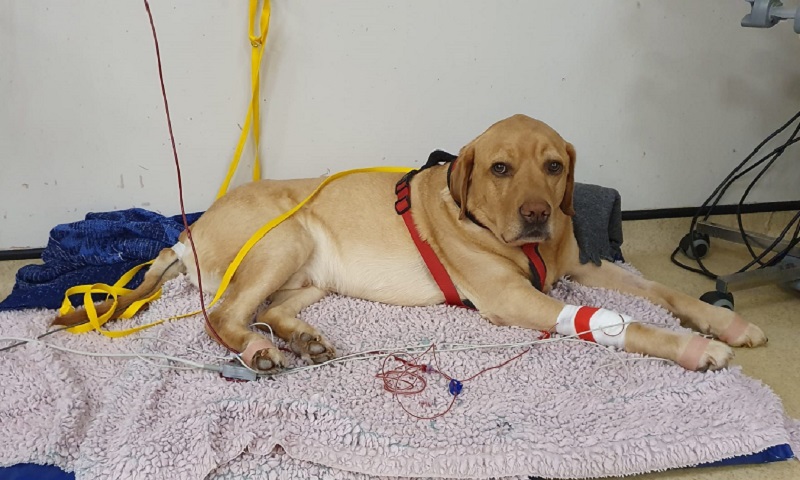Immune-mediated Haemolytic Anaemia Case
Clinical Connections – Spring 2022
Erica Tinson, Lecturer in Veterinary Emergency and Critical Care
Buddy, a six-year-old Labrador was presented to RVC Small Animal Referrals in early January for investigation of severe anaemia.
He was diagnosed with immune-mediated haemolytic anaemia (IMHA), which, in the absence of evidence of a trigger factor, was considered to be non-associative (idiopathic).
During physical examination, Buddy was quiet but alert and responsive. His mucous membranes were pale and icteric and capillary refill time was two seconds. His sclera were notably icteric. His cardiac auscultation was normal and did not identify a murmur or arrhythmia. His heart rate was 140bpm and his pulses were synchronous but bounding. His thoracic auscultation was unremarkable, and his respiratory rate was 36 per minute. He was soft and comfortable on abdominal palpation. His peripheral lymph nodes were normal on palpation.
Buddy remained under the primary care of the Critical Care Service due to his high dependency for blood products and the instability that caused. The Critical Care team discussed his case with the Internal Medicine team daily to maintain a wholistic approach to his care. In addition to this, the Diagnostic Imaging team were pertinent in the evaluation of underlying causes of his disease and the transfusion medicine team needed to be intimately involved to effectively plan for his blood products.
Buddy required packed red blood cell transfusions on five occasions from January 8th. Due to a high level of transfusion dependency and clinical deterioration, he also underwent therapeutic plasma exchange. He had 10 units of red blood cells – which had the transfusion team working very hard to keep up with the demand – and eight plasma transfusions.

The plasma exchange proceeded uneventfully, and Buddy showed signs of improvement over the following days. He was transitioned to oral prednisolone and azathioprine was added as a second immunosuppressive agent during his period of treatment at the RVC.
On the 18th of January Buddy developed marked hypoxaemia and dyspnoea that progressed to severe respiratory distress the following day. Investigations and clinical suspicion were consistent with pulmonary thrombosis.
Fortunately, Buddy made a good improvement over the next few days, though there persisted an ongoing risk of thromboembolic events due to his hypercoagulable state secondary to the IMHA and steroid treatment. Clopidogrel and rivaroxaban were started to treat this hypercoagulable state. Owners and referrers were therefore advised to expect Buddy to display intermittent tachypnoea. He is likely to need to anticoagulant therapy until his inflammatory state has resolved, which will be marked by his IMHA going into remission.
Buddy developed an abscess of this right thoracic limb while in hospital. It is suspected to be associated with a previous intravenous catheter. Fortunately, Buddy responded well to antimicrobial treatment, but was still lame on the day of discharge. For that, he was prescribed paracetamol and physiotherapy at home, in addition to additional analgesia if required.
Buddy's PCV at the time of discharge was 31%. The referring vets reviewed him 10 days later. Buddy’s PCV remained static post-discharge and a decision was made to start weaning his steroids slightly with a close watch on his blood work. He unfortunately is still lame and a review consultation with our Orthopaedic Service has been recommended. Another option for review of this ongoing lameness was for the primary care vet to take radiographs of the leg and the RVC team can help review them remotely.
If Buddy is clinically well and his PCV is improving, we can consider tapering his prednisolone dose at that stage by 25%. If he continues to respond well to treatment, his prednisolone dose can be tapered by 25% every two weeks as long as he is clinically well and physical examination and haematology, including blood smear examination, does not raise concerns of a relapse. Azathioprine will mostly likely be continued for eight weeks after the prednisolone has been stopped as long as there are no side effect with its use. We advised for serum biochemistry to be performed every six to eight weeks as long as Buddy is on azathioprine.
